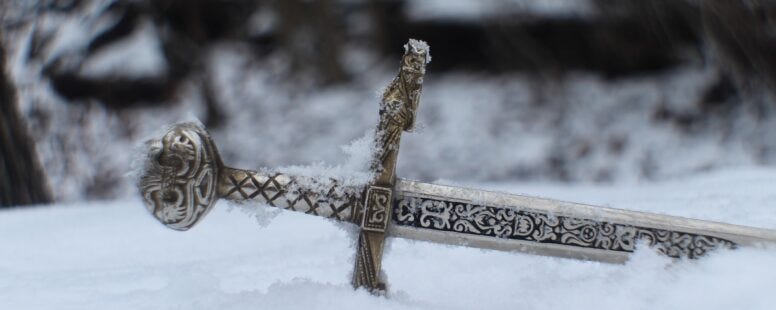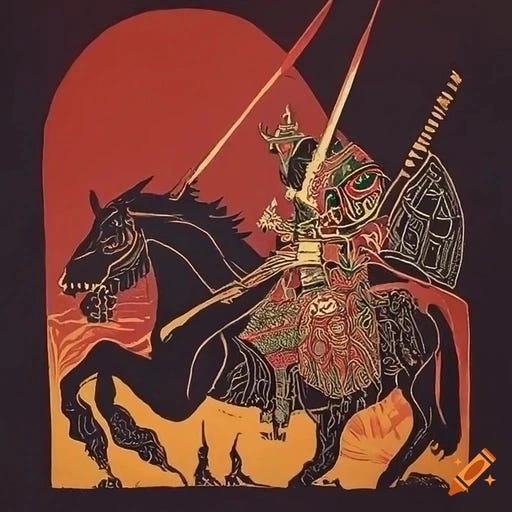Why sceptics can’t kill Dark Age kingdom of Rheged
Some deny Cumbria can trace its origins back to heroic King Urien - but here’s why the tales won’t go away.
One of the most alarming things about Cumbria is that large chunks of its history keep going missing.
Back in 1943, the great historian Sir Frank Stenton claimed that between the departure of the Romans from Britain in 410 AD and the emergence of the earliest English kingdoms 150 years later “there stretches a long period of which the history cannot be written.”
The problem with Stenton’s sweeping statement is that this period is precisely when Cumbria’s fabled predecessor Rheged and its semi-legendary King Urien are supposed to have emerged.
The story of Cumbria’s origins is important to people and the idea that there was a century and half of nothing after the Imperial legions departed is considered pretty implausible.
As a result, the masterminds in charge of marketing the Lake District created a visitors’ centre in the year 2000 and defiantly called it the Rheged Discovery Centre.
Partially buried underground, the attraction is well positioned to catch visitors coming off the M6 in Penrith. It currently attracts 40,000 travellers a year. With a pretend medieval gatehouse, an art gallery, shops, cafe and a 3D cinema it purports to inform tourists about the landscape and history of England’s most popular national park.
The very existence of the tourist hub with a Dark Age name gives the impression that the ancient kingdom really did exist and that we must know a lot about it. However, families calling in at the venue learn puzzlingly little about the place from which it takes its name.
Yet despite all the doubts, there is documentary evidence for Rheged. It consists of a book called Geography written by the Ancient Greek known as Ptolemy, poems composed in Rheged by a sixth century Welsh court poet known as Taliesin and lists of early medieval kings from the Old North compiled by monks.
But some of the best academic brains have poured over this evidence for a couple of hundred years and have failed to come up with a consensus either on whether Rheged existed or even where it was. Some historians are no longer prepared to give the elusive kingdom and its king whose legend once evoked such a sense of wonder and mystery the benefit of the doubt.
The most sceptical scholars say the trouble started with the 11th Century Welsh scribe Geoffrey of Monmouth. They complain that his 1136 book, the History of the Kings of Britain, which purportedly traced the story of the realm from its foundation by Brutus to the coming of the Saxons some two thousand years later was more myth than fact.
At one point, Geoffrey tells of a legendary king of the Britons based in the north of England called Urianus who lived two centuries before Christ. He was apparently based on the real Urien the King of Rheged, who lived in the sixth century after Jesus. Later, Geoffrey wrote stories about King Arthur and made Urien one of the main supporters of his entirely fictional hero and his round table. By mingling fact with myth, Geoffrey caused a lot of confusion which continues today.
As Cambridge University historian Geoffrey Ashe put it: “Monmouth is an entertaining and memorable companion, so long as one never believes anything he says.”
Another problem is that hardly any material objects have turned up to confirm Rheged’s existence, according to Mike McCarthy, former senior Archaeology lecturer at Bradford University. He declared in his 2017 book “Carlisle: A Frontier and Border City” that: “little of the Rheged legend is grounded in solid evidence.” But he conceded: “That is not to say that they are completely fictitious, because there may be kernels of truth in the stories about Urien.”
The latest historian to pour cold water on Rheged’s reality is the respected medievalist Thomas Williams. In an elegantly written 2022 book, Lost Realms, he concluded: “For those who seek its elusive shadow, the possibility must always be seriously entertained that the kingdom of Rheged never existed at all.”
But why worry if a Dark Age kingdom disappears from the map? Well, it matters to those Cumbrians who want to know who they are. One stark fact is historians can confidently name all the other post-Roman kingdoms - except the one for the north-west. For example, Bernicia covered southeastern Scotland and North East England; Deira encompassed the Humber to the Tees and Elmet was essentially today’s West Riding of Yorkshire. But there is a big hole where the predecessor of Cumbria should be.
As the historical novelist Carla Nayland put it in her blog there is archaeology indicating a succession of nameless rulers lived in early medieval Cumbria. At the same time there is a lot of sixth century poetry which names kings without definitely locating their kingdoms. “It seems reasonable to put the two together, and to surmise that …Rheged (was) probably to be found somewhere in this large region,” she wrote.
Uniting the two is more than guesswork. A neglected paper called “Rheged and Brigantia” was published in 1965 by the archaeologist Alexander Hubert Arthur Hogg, an expert on hill forts and the Celts.
He studied the ancient map of the known world made by Ptolemy who lived in the first century after Christ. It named nine towns that were in Brigantia, the Celtic kingdom that spanned the north of England before the Romans came. Five of them reappeared in the same area after the Romans left. In other words, Brigantia and Rheged covered roughly the same territory, he thought. “Territorially at least, Rheged was the successor of Brigantia,” Hogg claimed.
The places that were common to both kingdoms included: Carlisle, Lancaster, Catterick and somewhere called Llwyfenydd, or the River Lyvennet in the Eden Valley south of Penrith where King Urien is traditionally said to have had his palace.
These days, historians are not happy to accept Taliesin’s poetry as a reliable account of what happened in the past. They complain that the verses were originally composed in the sixth century and transmitted orally. They were probably drafted in the north west when Taliesin was a member of Urien’s court and only written down in 1275 at a monastery in Aberystwyth. For sceptical historians, that leaves too much time for the texts to be re-written and corrupted.
The other problem is the poems were essentially royal propaganda, written to praise the exploits of the heroic “Men of the North”. The Welsh upper classes promoted the valiant doings of the kings of Rheged as an ideal for youth to follow. Taliesin portrays Urien as not just a king - but an over-king who controlled an array of regional monarchs. “He restrains chieftains,” the Welsh bard wrote, “Kings of every tribe, all to you [Urien] are bound”.
Taliesin’s poems had a huge influence on the development of chivalry and the key works of medieval romantic literature such as La Chanson de Roland, Troilus and Criseyde, and Le Morte D'Arthur.
But this was not pure fiction. While we cannot take Taliesin’s work literally, the verses more than suggest there was a kingdom called Rheged in the distant past. It also indicates that the exploits of its kings and their families were circulating in later centuries.
Urien is portrayed in Taliesin’s poetry one of the most famed British commanders of his day: in other words, he was a Celtic warrior king good at killing the hated Anglo Saxon invaders (who eventually became the English). The real Urien was admired almost as much as the fictional Arthur.
Scholars have scoured Taliesin’s lines for clues about Rheged’s location. One of the most promising nuggets is Taliesin’s phrase “tra merin Regit” which has been translated as “across the sea of Rheged”. This is thought to refer to the Solway Firth, thus “proving” the link with Cumbria and, with a bit of a leap, Carlisle.
As a result, Carlisle has been assumed to have been Urien’s military headquarters because of its strategic position and the defensive location on an escarpment overlooking the river Eden. No archaeological evidence has turned up to prove this, however. But that does not mean there was no connection to the town, as we shall see.
Perhaps surprisingly, we are on rather firmer ground when seeking evidence for King Urien and his son Owein. They both appear in a bona-fide historical document called the Northern History or “Historia Brittonum”. It was compiled in 829 AD by a monk called Nennius who lived the place we now call Powys in Wales.
According to Nennius, Urien reigned between the 570s and 590. But he was assassinated whilst besieging the Anglo Saxons of Bernicia at Lindisfarne by a jealous rival, Morcant Bulc of south east Scotland.
Urien’s son Owein became king of Rheged on his father’s death in 590 and led the men of Rheged against the Bernicians under "Fflamddwyn" (Firestealer), possibly the Anglo Saxon king Theodric.
Owain was slain in battle by his father's old nemesis, Morcant Bulc, after which Rheged went into a decline. Owein’s great granddaughter, Princess Rieinmelth of Rheged, married Oswiu the King of Bernicia in 638 which led to a merger of the two kingdoms.
In 685, St Cuthbert visited Queen Iurminburg of Northumbria (a kingdom forged from the union of Bernicia and Deira) at a monastery in Carlisle. Her presence there was the result of the family inheriting Rheged through marriage fifty years previously - proving there was a definite link between Rheged, Urien and Carlisle after all.
This is an extract based on a chapter in a new book called The Trophy at the End of the World where there is a lot more about Rheged. You can buy it instantly here:
https://www.fletcherchristianbooks.com/product/the-trophy-at-the-end-of-the-world
Or you can pick up a copy from the New Bookshop, Main Street, Cockermouth, Bookends in Keswick or Carlisle and Sam Read in Grasmere.





